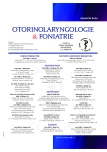Factors Affecting Vestibular Compensation in Patients after Vestibular Schwannoma Surgery
Authors:
Z. Balatková 1; R. Černý 2; Z. Fík 1; Sabina Hrubá 1; O. Čakrt 3; E. Zvěřina 1; J. Betka 1; J. Plzák 1; Z. Čada 1
Authors‘ workplace:
Katedra IPVZ, Klinika ORL a chirurgie hlavy a krku 1. LF UK a FN Motol, Praha
1; Neurologická klinika 2. LF UK a FN Motol, Praha
2; Klinika rehabilitace a tělovýchovného lékařství 2. LF UK a FN Motol, Praha
3
Published in:
Otorinolaryngol Foniatr, 67, 2018, No. 4, pp. 91-94.
Category:
Review Article
Overview
The aim of this study is to consider predictive factors influencing central vestibular compensation in patients who underwent surgery for vestibular schwannoma. Surgical removal of vestibular schwannoma causes acute peripheral vestibular loss due to surgical lesion to both branches of vestibular nerve and in some cases lesion of cerebellum. The postoperative symptoms are postural instability, vertigo, oscillopsia sometimes accompanied with vegetative symptoms. Factors affecting compensation may be divided into several groups. Firstly, general health status of a patient as well as the tumour itself affects the compensation, then actual state of function of vestibular system plays important role. Finally, compensation may be induced by therapist. Central compensation, in which cerebellum plays dominant role, influences duration of the symptoms. Therapeutic aim is to induce compensatory mechanisms as soon as possible and to reduce overall duration of the compensation. Early operated vestibular rehabilitation is currently the basic procedure. It leads to faster recovery in majority of patients. However, in some patients it is difficult to achieve full compensation despite maximum effort of physiotherapist and that results in permanent functional deficit manifesting with postural instability. Chemical prehabituation with gentamicin is one of the options how to achieve this goal. Ototoxic antibiotic is installed intratympanically which causes reduction of vestibular function and helps to start compensatory mechanisms already in preoperative period. Reduction of duration of the whole compensatory process and reduction of intensity of vertigo should be achieved.
Keywords
vestibular schwannoma, vestibular compensation, vestibular rehabilitation, chemical labyrinthectomy, prehabituation
Sources
1. Archana Rajagopalan, J. V., Kumar, S. S., Soumaya, M. et al.: Understanding the links between vestibular and limbic systems regulating emotions. J. Nat. Sci. Biol. Med., 8, 2017, 1, s. 11-15.
2. Balatková, Z., Čada, Z.: Chemická labyrintektomie. V: Čada, Z., Černý R., Čakrt, O.: Závratě. Havlíčkův Brod, Tobiáš, 2017, s. 423.
3. Betka, J., Zvěřina, E., Lisý, J. et al.: Vestibulární schwannom. Otorinolaryngologie a Foniatrie. 2008; 57:221–5.
4. Betka, J., Zvěina, E., Balogová, Z. et al.: Complications of microsurgery of vestibular schwannoma. Biomed. Res. Int., 2014; doi: 10.1155/2014/315952.
5. Cohen, H. S., Kimball, K. T., Jenkins, H. A.: Factors affecting recovery after acoustic neuroma resection. Acta Oto-Laryngologica, 122, 2002, s.841-850.
6. Cullen, K. E., Minor, L. B., Beraneck, M. et al.: Neural substrates underlying vestibular compensation: contribution of peripheral versus central processing. Journal of Vestibular Research, 19,2009, 5-6, s. 171-182.
7. Čada, Z., Balatková, Z., Chovanec, M. et al.: Vertigo perception and quality of life in patients after surgical treatment of vestibular schwannoma with pretreatment prehabituation by chemical vestibular ablation. BioMed Research International, 2016, Article ID 6767216, 6 pages, 2016. doi:10.1155/2016/6767216.
8. Čakrt, O., Truc, M., Kolář, P. et al.: Vestibulární rehabilitace - principy rehabilitace pacientů s poruchou vestibulárního systému. Neurologie pro praxi, 8, 2007, 6, s. 354-356.
9. Furman, J. M., Balaban, C. D., Pollack, I. F.: Vestibular compensation in a patient with a cerebellar infarction. Neurology, 48, 1997, s. 916-920.
10. Herdman, S. J., Clendaniel, R. A., Mattox, D. E. et al.: Vestibular adaptation exercises and recovery: acute stage after acoustic neuroma resection. Otolaryngology - Head And Neck Surgery,113, 1995, s.77-87.
11. Jacobson, G. P., Newman, C. W., Kartush, J. M.: Handbook of balance function testing. Mosby, 1992, s. 360.
12. Jirenhed, D. A., Bengtsson, F., Hesslow, G.: Acquisition, extinction, and reacquisition of a cerebellar cortical memory trace. The journal of neuroscience, 27(10), 2007, s. 2493-2502.
13. Lacour, M., Bernard-Demanze, L.: Interaction between vestibular compensation mechanisms and vestibular rehabilitation therapy: 10 recommendations for optimal functional recovery. Frontiers in Neurology, 5, 2015, s. 285.
14. Magnusson, M., Kahlon, B., Karlberg, M. et al: Preoperative vestibular ablation with gentamicin and vestibular ‘prehab’ enhance postoperative recovery after surgery for pontine angle tumours — first report. Acta Oto-Laryngologica, 127 (12),2007, s. 1236–1240.
15. Nellis, J. C., Sharon, J. D., Pross, S. E. et al.: Multifactor Influences of Shared Decision-Making in Acoustic Neuroma Treatment. Otology & Neurotology. 38(3), 392–399, 2017. http://doi.org/10.1097/MAO.0000000000001292
16. Rosahl, S., Bohr, C., Lell, M. et al.: Diagnostics and therapy of vestibular schwannomas – an interdisciplinary challenge. GMS Current Topics in Otorhinolaryngology, Head and Neck Surgery, 16, 2017. Doc03. http://doi.org/10.3205/cto000142.
17. Sundermier, L., Woollacott, M. H., Jensen, J. L. et al: Postural sensitivity to visual flow in aging adults with and without balance problems. Journals of Gerontology Series A: Biological Sciences and Medical Sciences, 51 (2), 1996, s. 45– 52.
18. Tjernström, F., Fransson, P. A., Kahlon, B. et al.: Vestibular PREHAB and gentamicin before schwannoma surgery may improve long-term postural function. Journal of Neurology, Neurosurgery and Psychiatry, 80(11), 2009, s. 1254–1260
Labels
Audiology Paediatric ENT ENT (Otorhinolaryngology)Article was published in
Otorhinolaryngology and Phoniatrics

2018 Issue 4
Most read in this issue
- The Etiology, Diagnostics, Nasal Defects Classification and History of Nasal Reconstruction
- The Physiology and Pathophysiology of the Nasal Airflow
- Manifestations of the Chronic Granulomatous Disease in ENT Locality
- Adenoid Cystic Carcinoma of the Trachea
